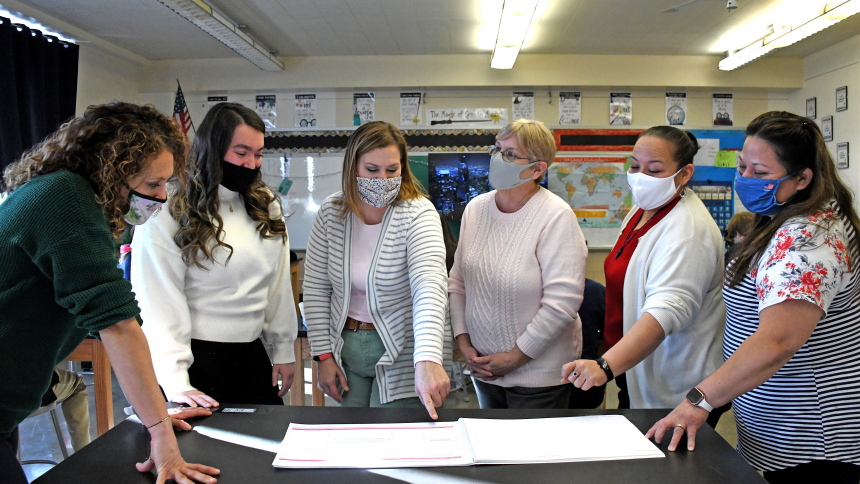
WHITING – A new collaboration promises to bring the excitement of a big city interactive science museum to a variety of different classes for students at St. John the Baptist Catholic School.
As a new partner institution, one of 13 in the Chicagoland area, SJB will benefit from the Museum of Science and Industry’s Science Leadership School Partners Program in many ways, according to Erin Wolfley, third-year junior high school science teacher.
St. John will realize a top-down curriculum evaluation, gain access to online and printed classroom resources for students and utilize exclusive museum access.
“We are blessed to have a diverse group of educators willing to serve on this team and are so excited to begin the journey,” Wolfley said.
Last spring, Wolfley noticed the SLSPP when she was browsing the website of the Chicago museum known for its hands-on interactive science and technology exhibits.
MSI offers the program at no cost to the school. However, a “competitive” application process took months to arrive at a ‘yes,’ from program officials.
“(The SLSPP) requires an initial application and, if selected, application essays and multiple rounds of interviews,” Wolfley explained. “Throughout the spring, we worked diligently to earn admission into the program and learned of our acceptance in May.”
Wolfley, who earned her Bachelor of Science degree in meteorology and geology at Ball State University, then later received her teacher certification, is a major fan of immersive learning.
“For me, it’s difficult to teach science when you can’t be hands on,” said Wolfley. “I love showing how it’s usable … how does this connect to the world around you?”
During the first year of the pandemic, Wolfley was already adapting to partly remote teaching when she found resources through an organization affiliated with the Discovery Channel’s “Shark Week” television program.
“It’s different when you’re talking about measurement and mapping and you’re following a great white shark and you later get to talk to someone who is researching these sharks,” she said.
Wolfley has great anticipation for a time when field trips can resume because MSI’s three-year program provides alumni benefits such as free admission to the interactive museum in Chicago and its countless hands-on exhibits.
SJB teachers and administrators have already completed a semester of collaborative analysis of teaching methods, incorporating the input from science and math instructors as well as those charged with language arts and religious education.
At first glance, many among the SJB team weren’t sure how the science-based initiative would relate to the subject matter they cover with their students. Yet with some outside-the-box thinking, some believe the science partnership could help deepen the connections children and teens make with their lessons.
“This partnership with the Museum of Science and Industry gives us the tools, flexibility, and opportunity to create engaging cross-curricular lessons to make those connections across subjects,” said second-grade teacher Elena Sobilo. “For example, instead of just reading the Bible story of David and Goliath, we can evolve the lesson to include an engineering challenge to build a catapult or sling-shot to mimic the tools that David used to beat Goliath.”
Sobilo said creativity in academics is essential when trying to connect with today’s elementary students.
“It is imperative to foster a love of learning and expose students to as many big ideas as possible in the younger grades,” said Sobilo, who is in her third year at SJB.
The Museum of Science and Industry’s model for “whole organization” development necessitates a school partner to bring forth a teacher leader – in this case, Wolfley – and a cross-disciplinary team. A school administrator oversees the roll-out of collaboration institution-wide.
Second-year St. John the Baptist Vice-Principal Michelle Wacnik spent seven years as a junior high school math and science teacher at the Whiting school. She said that background gave her the inspiration to “push” to be a part of the MSI program.
“(The Science Leadership School Partners Program) forces us to reflect on what we do well and what we need to improve on,” Wacnik said. “In order to do that, we must take a look at science from all grades levels as well as cross curricular. Bringing all these people together really helps us to get a full picture of where we are and where we are going.”
Wacnik continued, “This program is providing us with resources not only from MSI, but (also) from other schools involved in the program. We have access to not only paper resources but (also) people who can step in and offer advice and direction.”
Tipping her hat, especially for Wolfley’s initiative to bring the science collaborative to SJB, Wacnik said her school’s learning environment was already set-up for success.
“The faculty put in countless hours outside of the school day to ensure they do everything they can to promote personal success with each and every one of their students,” Wolfley said. “The students at St. John are full of kindness and motivation. They work hard every day to ensure they don't waste their chance at a great education.”
